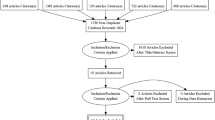Abstract
Objective
Despite their benefit for detecting primary tumors, data for normal 18F-fluoro-2-deoxy-d-glucose (FDG) uptake in the anal canal are insufficient. Here we used positron emission tomography–computed tomography (PET/CT) to determine the uptake of FDG in the normal adult anal canal (AC) and to evaluate its clinical significance compared with that of anal cancer.
Methods
We conducted a retrospective study of–PET/CT images in the anal region, of 201 consecutive patients without symptoms or pathology taken from January 2015 to August 2019, after excluding two patients (one each with Crohn’s disease and hemorrhoid). These patients were included in the normal group, and data of eight patients with anal cancer were collected from January 2011 to August 2019 for comparison. FDG uptake was quantitatively evaluated (compared with the maximum standardized uptake value [SUVmax] to the SUVmax values of liver and distal rectum) and qualitatively (compared with background) in early and delayed phases. Normal grade 3 uptake was qualitatively defined as FDG uptake higher than the surrounding muscles.
Results
In the normal group, mean anal canal SUVmax of early phase was: 2.26 (range 1.00–6.30), and delayed phase: 2.52 (range 1.00–8.80). Their ratios to liver SUVmax were early: 0.74 (range 0.24–2.25), and delayed: 0.81 (range 0.23–2.32); ratios to rectal SUVmax were early: 0.87 (range 0.30–1.89), and delayed: 0.90 (range 0.30–1.27). Qualitatively, 25 patients (15.4%) had normal grade 3 uptake during the early and delayed phases. In contrast, qualitative data showed that all patients with anal cancer exhibited high FDG uptake in the anal canal. The mean early- and delayed-phase values of SUVmax of the anal canal and anal cancer group were 11.09 (range 5.40–17.73) and 14.23 (range 6.70–22.85), respectively. There was a significant difference between the mean-early and -delayed anal SUVmax values of the normal grade 3 and anal cancer groups. Furthermore, the ratios to liver SUVmax were significantly different between the two groups.
Conclusions
PET/CT scans occasionally showed high FDG uptake in the anal canal of healthy adults. Comparing the SUVmax values of liver FDG uptake may help differentiate between normal tissue and anal cancer.





Similar content being viewed by others
References
Amirian ES, Fickey PA, Scheurer ME, Chiao EY. Anal cancer incidence and survival: comparing the greater San-Francisco Bay area to other SEER cancer registries. PLoS ONE. 2013;8:e58919.
Agarwal A, Marcus C, Xiao J, Nene P, Kachnic LA, Subramaniam RM. FDG PET/CT in the management of colorectal and anal cancer. AJR. 2014;203:11091119.
Koh DM, Dzik-jurasz A, O’neill B, et al. Pelvic phased-array MR imaging of anal carcinoma before and after chemoradiation. Br J Radiol. 2008;81:91–8.
Wells IT, Fox BM. PET/CT in anal cancer—is it worth doing? Clin Radiol. 2011;67:535–40.
Shane EC, Perry WG, Barry AS, Farrokh D, Robert SM, James WF, Elisa HB, Xia W, Elliot A. FDG-PET/CT in the evaluation of anal carcinoma. Int J rad oncol. 2006;65:720–5.
Vercellino L, Montravers F, Deparades V, Huchet V, Kerrou K, Bauer P, Touboul E, Talbot JN. Impact of FDG PET/CT in the staging and the follow-up of anal carcinoma. Int J Colorectal Dis. 2011;26:201–10.
Kostakoglu L, Hardoff R, Mirtcheva R, et al. PET-CT fusion imaging in differentiating physiologic from pathologic FDG uptake. Radiographic. 2004;24:1411–31.
Blake MA, Singh A, Setty BN, Slattery J, Kalra M, Maher MM, Sahani DV, Fischman AJ, Mueller PR. Pearls and pitfalls in interpretation of abdominal and pelvic PET-CT. RadioGraphics. 2006;26:1335–533.
Saboo SS, Zukotynski K, Shinagare AB, Krajewski KM, Ramaiya N. Anal carcinoma: FDG PET/CT in staging, response evaluation, and follow up. Abdom Imaging. 2013;38:728–35.
Tsai SC, Jeng LB, Yeh JJ, Lin CC, Chen JH, Lin WY, Kao CH. Findings of 2fluoro-2-deoxy-d-glucose positron emission tomography in hemorrhoids. Abdon Imaging. 2011;36:548–51.
Malham M, Hess S, Nielsen RG, Husby S, Hoilund PF. PET/CT in the diagnosis of inflammatory bowel disease in pediatric patients: a review. J Nucl Med Mol Imaging. 2014;4:225–30.
Toriihara A, Yoshida K, Umehara I, Shibuya H. Normal variants of bowel FDG uptake in dual-time-point PET/CT imaging. Ann Nucl Med. 2011;25:173–8.
Lee JM, Kim NK. Essential anatomy of the anorectum for colorectal surgeon focused on the gross anatomy and histologic findings. Ann Coloproctol. 2018;34:59–71.
Yasuda S, Takahashi W, Takagi S, Fujii H, Ide M, Shohtsu A. Factors influencing physiological FDG uptake in the intestine. Tokai J Exp Clin Med. 1998;23(5):241–4.
Abouzied MM, Crawford ES, Nabi HA. 18FFDG imaging: pitfalls and artifacts. J Nucl Med Technol. 2005;33:145–55.
Prabhakar HB, Sahani DV, Fischman AJ, Mueller PR, Blake MA. Bowel hot spots at PET-CT. Radiographics. 2007;27:145–59.
Zhang L, Liang M, Zhang Y, Hu S, Chen L, Li H, Wang J. The effects of hypotonic and isotonic negative contrast agent on gastrointestinal distention and physiological intake of 18F-FDG. Nucl Med Comm. 2015;36:180–6.
Naganawa S, Yoshikawa T, Yasaka K, Maeda E, Hayashi N, Abe O. Role of delayed-time-point imaging during abdominal and pelvic cancer screening using FDG-PET/CT in the general population. Medicine (Baltimore). 2017;96:e8832.
Kidd EA, Dehdashti F, Siegel BA, Grisby PW. Anal cancer maximum F-18 fluorodeoxyglucose uptake on positron emission tomography is correlated with prognosis. Radiother Oncol. 2010;95:288–91.
Acknowledgements
We thank Edanz Group (www.edanzediting.com/ac), for editing a draft of this manuscript. The authors declare no conflict of interest.
Author information
Authors and Affiliations
Corresponding author
Additional information
Publisher's Note
Springer Nature remains neutral with regard to jurisdictional claims in published maps and institutional affiliations.
Rights and permissions
About this article
Cite this article
Sena, Y., Matsumoto, S., Silman, C. et al. Physiological 18F-FDG uptake in the normal adult anal canal: evaluation by PET/CT. Ann Nucl Med 34, 538–544 (2020). https://doi.org/10.1007/s12149-020-01480-9
Received:
Accepted:
Published:
Issue Date:
DOI: https://doi.org/10.1007/s12149-020-01480-9




